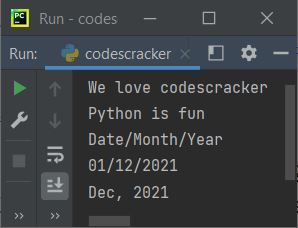- Python Built-in Functions
- Python All Built-in Functions
- Python print() Function
- Python input() Function
- Python int() Function
- Python float() Function
- Python len() Function
- Python range() Function
- Python str() Function
- Python ord() Function
- Python chr() Function
- Python ascii() Function
- Python pow() Function
- Python type() Function
- Python List Functions
- Python list() Function
- Python insert() Function
- Python append() Function
- Python extend() Function
- Python pop() Function
- Python remove() Function
- Python reverse() Function
- Python sort() Function
- Python sorted() Function
- Python Dictionary Functions
- Python dict() Function
- Python update() Function
- Python get() Function
- Python keys() Function
- Python setdefault() Function
- Python fromkeys() Function
- Python items() Function
- Python popitem() Function
- Python Tuple Function
- Python tuple() Function
- Python Set Functions
- Python set() Function
- Python frozenset() Function
- Python String Functions
- Python split() Function
- Python join() Function
- Python format() Function
- Python replace() Function
- Python Iterator Functions
- Python iter() Function
- Python min() Function
- Python max() Function
- Python sum() Function
- Python count() Function
- Python index() Function
- Python copy() Function
- Python clear() Function
- Python next() Function
- Python filter() Function
- Python enumerate() Function
- Python zip() Function
- Python reversed() Function
- Python Number Functions
- Python abs() Function
- Python bin() Function
- Python oct() Function
- Python hex() Function
- Python round() Function
- Python divmod() Function
- Python complex() Function
- Python File Handling Functions
- Python open() Function
- Python read() Function
- Python readable() Function
- Python readline() Function
- Python readlines() Function
- Python write() Function
- Python writable() Function
- Python writelines() Function
- Python close() Function
- Python seek() Function
- Python tell() Function
- Python flush() Function
- Python fileno() Function
- Python truncate() Function
- Python Class Functions
- Python object() Function
- Python property() Function
- Python getattr() Function
- Python setattr() Function
- Python hasattr() Function
- Python delattr() Function
- Python classmethod() Function
- Python staticmethod() Function
- Python issubclass() Function
- Python super() Function
- Python Misc Functions
- Python all() Function
- Python any() Function
- Python isatty() Function
- Python bool() Function
- Python callable() Function
- Python globals() Function
- Python locals() Function
- Python dir() Function
- Python id() Function
- Python isinstance() Function
- Python map() Function
- Python repr() Function
- Python slice() Function
- Python vars() Function
- Python Advance Functions
- Python help() Function
- Python hash() Function
- Python breakpoint() Function
- Python bytes() Function
- Python bytearray() Function
- Python memoryview() Function
- Python compile() Function
- Python eval() Function
- Python exec() Function
- Python Tutorial
- Python Tutorial
- Python Examples
- Python Examples
Python join() Function
The join() function in Python is used when we need to join all the items of an iterable into a string. For example:
mylist = ["01", "Dec", "2021"] str = "-" res = str.join(mylist) print(res)
The output will be:
01-Dec-2021
Python join() Function Syntax
The syntax of join() function in Python, is:
str.join(iterable)
where str refers to the string and iterable refers to an iterable object. When dictionary is used as an iterable, their keys will get used.
Note: The str acts as a separator among all the joined items of specified iterable.
Python join() Function Example
Here is an example of String.join() function in Python:
a = ["We", "love", "codescracker"] b = ("Python", "is", "fun") c = {"Date": "01", "Month": "Dec", "Year": "2021"} d = {"01": "Date", "12": "Month", "2021": "Year"} e = {"Dec", "2021"} m = " ".join(a) n = " ".join(b) o = "/".join(c) p = "/".join(d) q = ", ".join(e) print(m) print(n) print(o) print(p) print(q)
The snapshot given below shows the sample output produced by above program, demonstrating the join() function in Python:

Of course the above program can also be created in this way too:
print(" ".join(["We", "love", "codescracker"])) print(" ".join(("Python", "is", "fun"))) print("/".join({"Date": "01", "Month": "Dec", "Year": "2021"})) print("/".join({"01": "Date", "12": "Month", "2021": "Year"})) print(", ".join({"Dec", "2021"}))
« Previous Function Next Function »